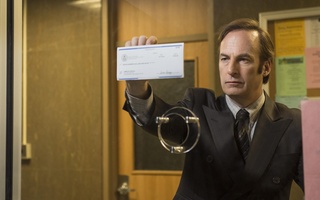{shortcode-b851e1b62f9a42517f8417c3e05c065784a6100f}
Hungarian director László Nemes holds nothing back in “Saul Fia,” his powerful directorial debut which was screened in competition at Cannes this year. It is rare for a director’s first film to earn the distinction of competing for the Palme d’Or, but Nemes’s film does so with aplomb. Moving at a grueling, breakneck pace, “Saul Fia” takes place inside a Nazi extermination camp and portrays the story of Saul, a Sonderkommando—one of many specially designated Jewish prisoners who were forced to assist the Nazis in their day-to-day operations.
From the film’s very first scene, the camera follows Saul (Geza Röhrig) as he moves swiftly throughout the camp and performs his various duties: picking up clothes, scrubbing bloody floors, and moving the bodies of dead Jewish prisoners out of gas chambers towards the furnaces. The film follows him quite literally—nearly the entire film is composed of lengthy tracking shots that closely shadow Saul around the camp, courtesy of cinematographer Mátyás Erdély. The audience is treated to constant close-ups of Saul’s face or shots from a perspective directly behind him that give the impression of physically being present and seeing the events of the film from his eyes. The film’s impossibly fast rhythm mimics the swift pace of the Nazi death camp, while its unusual, squarish aspect ratio and frequent manipulation of focus render much of Saul’s immediate surroundings indistinct, leaving only the film’s chaotic soundscape to imply the atrocities taking place around him.
“Saul Fia” focuses on the protagonist’s obsessive desire to provide a proper Jewish burial for a boy whose corpse he discovers in a gas chamber and whom he claims as his son. It’s unclear whether the boy is actually related to him—two separate scenes suggest that he actually is not—but Saul nevertheless on multiple occasions risks his own life and those of other prisoners who are planning a rebellion by stealing the boy’s body from the autopsy room and asking around for a Rabbi to say Kaddish. The film’s greatest weakness is in this narrative uncertainty—why would Saul go to such lengths to bury someone unrelated to him? It’s suggested that a proper Jewish burial is a symbolic victory against the Nazis—but even so, it doesn’t make sense that the other prisoners would continue to involve such an unreliable person in critical parts of their rebellion plans. Still, in the midst of Nemes’s wonderfully controlled chaos, big-picture narrative concerns fall to the wayside. As does Saul, the film moves swiftly from one scene to the next, and the utterly unpredictable and horrifying events that seem to occur every other minute make it an unsettling yet unforgettable experience.
Read more in Arts
From Cannes: Precocious "Afterthought" a Startling DebutRecommended Articles
-
Special Notice.No theatrical man in Boston enjoys greater popularity than Mr. Saul J. Hamilburg, treasurer of the Park, and his hosts
-
BELATED MILLENIUM ARRIVESThe millenium has arrived at last. Tonight is the night that put the Time in Pastime. At the hour of
-
BOOKENDS: GIs Passed Over by HistoryWilliam J. Shapiro is a retired obstetrician who now lives alongside a golf course in a gated community like so
-
 'Better Call Saul' a Show of Its Own
'Better Call Saul' a Show of Its Own -
From Cannes: Woody Allen's "Irrational Man" Finest YetIn our continuing coverage of Cannes, Alan Xie reviews Woody Allen's "Irrational Man," which is the director's finest film in some years and perhaps his finest ever.













